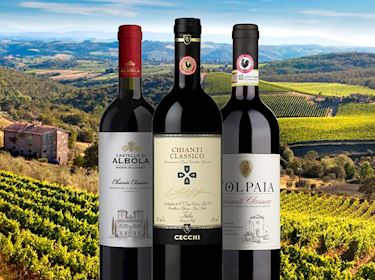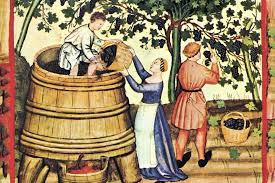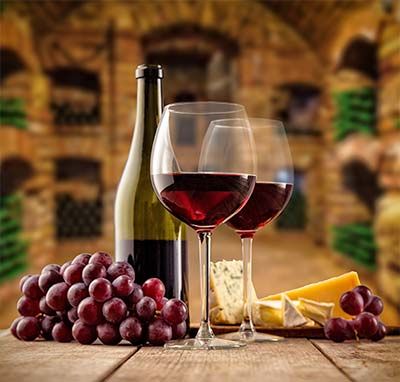Wine in Tuscany
Italy is blessed when it comes to producing wine – its climate, and the different soil types create ideal growing conditions for a number of different grape varieties. Although wine is produced throughout much of Italy, Tuscany is the most enduringly famous wine growing region of them all. The region’s climate is temperate meaning it never gets too wet or too dry – optimal conditions for wine growing – or viticulture. Tuscany is famous for its spectacular landscape of rolling hills; in wine making, elevated vines means the grapes maintain their balance of sugars and acidity as well as their aromas, which altogether makes for a superb wine. Although the soil of Tuscany is very poor and produces lower yields, the quality of their wine is optimum.

History of wine in Tuscany
Tuscany’s wine growing expertise dates back 2,700 years to the Etruscans, an ancient civilisation who predated the Romans. As the Romans were just finding their feet in 5th century BC, the Etruscans were already exporting wine as far as Gaul (France and Belgium). Under the Etruscans and Romans wine production flourished. By the medieval period wholesale production had ceased and only the monasteries produced wine. As the aristocratic and merchant class emerged at the turn of the millennium wine production became big business again. In Florence the earliest reference to wine merchants’ dates to 1079 and the wine producer’s guild was created in 1282. Wine has been big business in Tuscany ever since.

Classification – quality of your wine
When you are buying Italian wine how do you know if you are buying a good wine? Like France, Italy has a classification system which determines the quality of its wine, although it is much simpler than the dizzying French ‘appellation’ system. In fact, it was in Tuscany that the first DOC and DOCG zones—establishing criteria for quality were established. Italy takes its wine production very seriously and so it is heavily regulated, with hefty fines if the rules are not adhered to. There are several variations to this classification, but the main three are as follows:
Indicazione di Geografica Tipica (IGT)
This classification is concerned with the origin of the grapes, rather than the variety or type of wine. IGT wines use grapes that come from a specific geographical region. Most IGT are simple, easy-drinking wines just a cut above table wine, and are not expensive
Denominazione di Origine Controllata (DOC)
Wines labelled DOC are produced in a specific region as per the IGT above but also determine the way the wine is made. DOC wines must comply to rules that protect local traditions and quality of the wine. Only native Italian grapes may be used and the wine must be made in the traditional way. These wines are usually better quality than IGT wines and so have a higher price tag.
Denominazione di Origine Controllata e Garantita (DOCG)
This is the highest classification in the system. DOCG wines meet all the above criteria but are made under much stricter rules that control yield, alcohol levels and minimum barrel and bottle ageing criteria. DOCG wines will carry a label stamped with a number on it which guarantees its quality and origin. The producers of these wines are strictly controlled and can only produce a certain number of bottles per harvest (hence the numbered label).
Super Tuscan wine
Super Tuscans are an unofficial category of Tuscan wines, not recognized within the Italian wine classification system. In the 1970s Chianti had to be no more than 70% Sangiovese and had to include at least 10% of one of the local white wine grapes; Chianti wines sales were suffering and widely perceived to have fallen in quality because of these restrictions. Hence the Super Tuscan wines emerged. The quality is by no means low, but they use different varieties of grape from outside the region (not IGT) and use different blends that do not adhere to the DOC regulations. Today they have become incredibly popular and so strive to adhere to the old classification.

Grapes and Wines of Tuscany
Even if you are not a wine afficionado you will most certainly have heard of Chianti – Hannibal Lector’s famous tipple in Silence of the lambs. More than 80% of Tuscany’s wine production is red, predominantly from the Sangiovese grape such as Chianti, Brunello di Montalcino and Vino Nobile di Montepulciano. Other local red grape varieties include Canaiolo, Colorino, Malvasia nera and Mammolo.
Despite the region being famous for hearty full-bodied red wines, Tuscany also produces white wine that predominantly come from the Vernaccia grape which is the basis of their exquisite white wine Vernaccia di San Gimignano. The Medieval poet Dante sang the praises of Vernaccia di San Gimignano – already known in the late middle ages. Other grapes used predominantly for white wines are Vermentino, Trebbiano and Malvasia these are often blended with other grape varieties to produce a different flavour, acidity and aroma.

Vin Santo – Tuscany’s Dessert Wine
-
Many regions in Italy produce sweet wines known as ‘passito’ or dessert wine to us. Most are made with grapes that are dried in the sun before fermentation (the appassimento method). The drying technique concentrates the sugar content of the grapes, creating rich, honeyed wines balanced by natural acidity.
Vin Santo or holy wine is Tuscany’s renowned passito. As with all passito it is produced using the last harvest of the season which produces less wine but of an exceptional quality. Traditionally this wine was drunk on Easter Sunday with a huge brunch of rich chesses salami and eggs.
In Tuscany Vin Santo appears on the dessert menu and is served with hard cantucci biscuits. Whilst seemingly not refined, the tradition is to dunk the biscuit into the wine and suck the wonderful flavours before eating the biscuit. If you buy Vin Santo as a souvenir – don’t forget the biscuits!
You are now ready to explore the region’s wines for yourself; we have given you the basic knowledge to hop from place to place and try the best that area has to offer. Still want to know more?? Thanks to Tuscany’s popularity there are numerous options if you want to learn more including wine tasting, short wine courses and of course wine tours. If you don’t want to worry about navigating your way around and driving, there are a multitude of wine tours that cater for every taste; from day tours with wine tasting, vineyard hopping, lunch and time to explore quaint hilltop villages like Pienza, San Gimignano or Montepulciano. Or perhaps you want to learn more about a particular wine like the super Tuscans or Brunello di Montalcino. From wine tastings to full day packages you can choose to sit back and relax with exquisite wines in unforgettable places.
